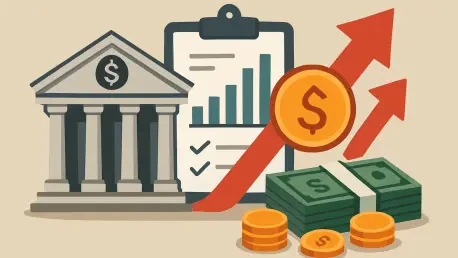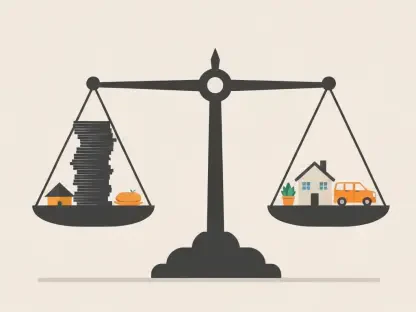In a world where the cost of living seems to climb relentlessly, a staggering 75% of global economies are wrestling with inflation rates above their central banks’ targets, painting a grim picture for many. Picture households stretching budgets thinner each month, businesses hesitating to invest, and markets jittering with every policy announcement. This is the reality in 2025, as major central banks across the G10 economies—from the U.S. Federal Reserve to the Bank of Japan—face a pivotal question: is it time to halt the era of rate cuts? This shift could redefine financial landscapes, impacting everything from mortgage payments to corporate loans, and it’s a story that demands attention.
The importance of this moment cannot be overstated. Central banks have been the backbone of economic recovery since the post-pandemic slowdown, slashing interest rates to historic lows to spur growth. Now, with inflation proving stubbornly persistent and signs of economic resilience emerging, a pivot toward pausing or even reversing these cuts signals a new chapter. This transition affects not just policymakers but every consumer, investor, and business navigating tighter credit conditions. Understanding why and how this change is unfolding offers critical insight into the future of global markets and personal finances.
A Turning Point in Global Monetary Policy
Across the globe, a subtle yet profound shift is reshaping monetary strategies among the most influential financial institutions. The aggressive rate-cutting cycles that defined recent years are slowing, as central banks grapple with balancing economic growth against rising price pressures. From Washington to Tokyo, policymakers are reevaluating the need for cheap money, sparking intense debate over whether this marks the end of an era of easy credit.
This hesitation stems from a collision of inflation concerns and unexpected economic strength in many regions. Data shows inflation lingering above targets in key economies, prompting institutions like the Federal Reserve and the European Central Bank to reconsider further stimulus. Meanwhile, robust recovery signals in some areas reduce the urgency for additional cuts, setting the stage for a broader policy rethink that could ripple through financial systems worldwide.
Markets are already feeling the tremors of this potential pivot. Investor sentiment fluctuates with each central bank statement, as the prospect of higher borrowing costs looms large. This turning point is not just a technical adjustment but a fundamental change that could alter how businesses plan, how families budget, and how economies stabilize in the coming years.
Why the Shift in Rate Policy Matters Now
Central banks have long wielded interest rates as a tool to steer economies through turbulent times, cutting them sharply during crises to encourage spending and investment. After years of historic lows to counter pandemic fallout, the current move to pause or reverse these reductions heralds a significant departure. This shift is driven by inflation rates that refuse to budge, threatening to erode purchasing power across households and businesses alike.
The implications of this policy change touch every corner of daily life. Higher interest rates could mean increased costs for mortgages, car loans, and credit card debt, squeezing consumer budgets further. For companies, borrowing to expand or innovate becomes pricier, potentially slowing job creation and economic momentum at a time when stability is paramount.
Investors, too, face a new reality as markets brace for volatility. Stock valuations, often buoyed by low rates, may face downward pressure, while bond yields could rise, reshaping portfolios. This juncture underscores the urgency of grasping these policy dynamics, as they influence not just abstract economic indicators but the very fabric of financial decision-making for millions.
Dissecting the Global Trend of Policy Normalization
A closer look at the G10 central banks reveals a complex tapestry of decisions shaped by unique regional challenges and shared global pressures. Inflation remains a dominant force, with Australia’s Reserve Bank holding steady at 3.60% amid persistent price hikes and a hot housing market, while Norway’s Norges Bank maintains 4% to curb above-target inflation. These stances reflect a cautious move away from easing, prioritizing price stability over further stimulus.
Economic resilience also plays a critical role in this trend, reducing the need for aggressive cuts in several areas. The European Central Bank, for instance, keeps its deposit rate at 2%, buoyed by recovery signs in the Euro Zone, while the U.S. Federal Reserve’s recent 25 basis point cut met internal resistance due to strong economic data. Meanwhile, external factors like geopolitical risks and currency shifts add complexity—Canada’s Bank of Canada, despite cutting to 2.25%, faces U.S. trade tariffs that temper further easing.
Divergence exists as well, with the Bank of Japan standing apart by considering rate hikes to bolster the yen and meet economic projections. This patchwork of policies illustrates a broader consensus: most central banks are leaning toward stabilization rather than continued easing. Market expectations align with this, projecting minimal cuts through 2027, signaling a global normalization that could redefine monetary frameworks for the foreseeable future.
Voices from the Field: Expert Insights and Market Sentiments
As this policy shift unfolds, economists and market analysts offer a sobering perspective on the road ahead. A recent poll of strategists indicates the European Central Bank’s easing cycle is nearly exhausted, with less than a 50% likelihood of further cuts by mid-2027. In the U.S., market odds for a December rate cut have plummeted from 84% to 60%, reflecting uncertainty fueled by robust data and internal Fed disagreements.
One prominent analyst commented, “Central banks are now placing inflation control above growth stimulus, even in economies still on shaky ground.” This sentiment resonates across trading floors, particularly in Australia, where no easing is anticipated until well into 2027 due to persistent price pressures. Such expert views highlight a data-driven caution that is reshaping expectations worldwide.
Trader reactions further amplify this hesitance, with bond and equity markets adjusting to the prospect of sustained or rising rates. In regions like New Zealand, despite a recent 50 basis point cut to 2.5%, high inflation near the target ceiling casts doubt on further reductions. These collective insights paint a picture of a monetary landscape increasingly defined by restraint and vigilance, as stakeholders brace for tighter conditions.
Navigating the New Normal: What Stakeholders Can Do
With central banks charting a course toward policy normalization, actionable steps can help individuals and businesses weather the transition. Keeping a close eye on inflation trends and official statements from institutions like the Federal Reserve or the Bank of England is essential. These communications often provide early clues about rate movements, directly affecting loan terms and investment returns.
Financial planning also demands a fresh approach in this environment. Securing fixed-rate loans or mortgages now could shield against rising borrowing costs, while reassessing budgets to account for tighter credit is prudent. Diversifying investment portfolios to include assets less sensitive to rate fluctuations offers another layer of protection against market swings driven by policy uncertainty.
For businesses, stress-testing financial strategies under scenarios of reduced credit availability is a wise precaution, especially in economies like Canada, where external pressures compound domestic challenges. Staying agile and informed in this evolving landscape transforms potential risks into manageable adjustments. Proactive measures, grounded in awareness of central bank directions, empower stakeholders to adapt effectively to this new monetary reality.
Looking back, the journey of central banks through 2025 revealed a delicate balancing act between curbing inflation and supporting growth, a challenge that tested the resolve of policymakers worldwide. Their cautious pivot away from rate cuts marked a defining chapter in global finance, reshaping how economies approached stability. Moving forward, the focus shifted to equipping consumers and businesses with tools to navigate higher borrowing costs—whether through smarter financial planning or vigilant monitoring of policy signals. The emphasis rested on building resilience, ensuring that the lessons of this period paved the way for sustainable adaptation in an ever-shifting economic terrain.









